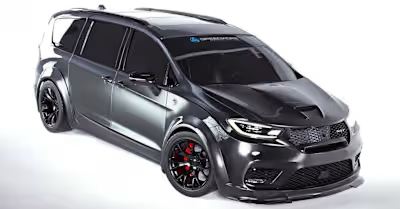The Real Reason The American-Spec 2024 Ford Ranger Raptor Makes…
The long wait is over— Ford has announced that its Ford Ranger Raptor will finally be available in the United States starting this year. Equipped with the most powerful engines and rugged suspension available in the F-150, Ranger, and Bronco lines, the Raptor nameplate is much heralded as the best-of-the-best when it comes to off-road performance in Ford vehicles. However, despite the Ranger Raptor being first introduced in 2019, Ford was quick to announce that the pickup would not be available in the North American market until its second generation. Now, the second generation Ranger Raptor is finally here and will be available in the United States and Canada close to a year after it hit showrooms in Australia. The specs are exciting, with the engine boasting 405 horsepower and 430 pound-feet of torque, but there is something peculiar about these numbers. Despite the North American version of the 2024 Ford Ranger Raptor being equipped with the same 3.0-liter twin-turbo V6 as its counterpart down-under, the US version boasts 13 more hp than the Australian version, which clocks in at 392 hp. Is the U.S. getting a more powerful version of the Ranger Raptor? Rather than a more powerful engine tune, the difference comes down to how the numbers are crunched.
American Testing Standards Make US Ranger Raptor Seem More Powerful
So why does the American-Spec Ford Ranger Raptor make more hp on paper? The answer lies in the difference in testing standards used in Australia versus the United States. In North America, power outputs are typically recorded in imperial horsepower to SAE standards. The SAE, or Society of Automotive Engineers, uses the same formula for horsepower devised by the late eighteenth century engineer James Watt. Watt’s formula for horsepower calculates the amount of work it takes to lift 33,000 pounds one foot vertically in one minute. Still following?
Not everyone uses imperial measurements. Unlike in the United States, power outputs in Australia and Europe are typically published in kilowatts, rather than horsepower. Australia has been using the kilowatt (kW) as the standard measurement of power output from an engine since the 70s, when metric SI units were adopted as the standard. You may see other abbreviations around the world when it comes to measuring power output. Germany has ‘PS,’ Italy and France have ‘CV,’ but what all of these abbreviations have in common is that they all translate to “horsepower” in their respective languages and are measures of metric horsepower, rather than imperial horsepower. In metric terms, the formula for horsepower is the amount of work it takes to lift 15,000 kg approximately 300 mm in one minute. Here is the crucial difference: while one unit of imperial horsepower is the equivalent of 0.7457 kilowatts, one unit of metric horsepower is equivalent to only 0.7355 kilowatts.
So does the North American version of the Ford Ranger Raptor really produce 13 more hp than the Australian version? It’s unlikely that Ford re-tuned their engine for America market, and the discrepancy probably has to do with imperial versus metric horsepower. If you put an Australian-spec Ranger Raptor on the same dynamometer as its American counterpart, you would likely see the same power output.
Why Ford Took Its Time Bringing The Ranger Raptor Stateside
With such high anticipation for the Ranger Raptor, why did Ford take so long to bring the high-performance pickup truck to the North American market? After all, the marketing of the model would have allowed Ford to directly compete with the Chevrolet Colorado ZR2, another off-road beast. One reason may be the risk of market overlap with the ever-popular F-150 Raptor, the bigger brother of the Ranger Raptor, whose demand often exceeds supply. Another reason is the Ranger Raptor’s powertrain design. The 2.0-liter EcoBlue diesel engine offered in Australia was not yet approved for US emissions standards. The diesel engine also had a similar output to the standard Ranger’s 2.3 liter EcoBoost gasoline engine. Ford cited cost concerns for an engine redesign to a more powerful Raptor version.
The second generation Ranger Raptor was unveiled in February 2022. While the turbo-diesel four- and six-cylinder versions available in Australia and Europe will still not be coming to the US, the gasoline version of the Ranger Raptor shares the same twin-turbo 3.0 liter EcoBoost V6 engine, along with the same 10 speed automatic transmission across both markets. The Ranger Raptor is available in Europe, as well, though its power output is limited to 282 hp to meet the stricter EU emissions standards. The Ford Ranger Raptor comes with four-wheel drive as standard, locking front and rear differentials, higher ground clearance, more rugged off-road tires, and an eye-catching grille that is unique to the Raptor line.
New And Unique Features Of The Upcoming US-Spec Ford Ranger Raptor
The upcoming Ford Ranger Raptor has some exciting updated features. The 2024 Ford Ranger model has a firmed-up chassis, Watts-linkage coil-spring rear suspension, and Fox adaptive shock absorbers, which are sure to smooth out any off-road course or rock crawl. The updated Ranger Raptor also features a multi-mode sport exhaust and 17-inch alloy wheels with optional beadlock capabilities. Inside, the Raptor's tech features carry over from the Australian market, complete with digital instrument clusters, 10.1 or 12 inch portrait touchscreens, and advanced safety technology, such as adaptive cruise control.
While the US model is very closely related to the Australian counterpart, with the same underpinnings, interior, and technology, there are a few features unique to the upcoming North American version. On the exterior, the US version of the Raptor will have a sliding opening in the rear window, side marker reflectors on the front wheel arches, as well as some exclusive colors and alloy wheel designs. Those alloy wheels will be equipped with 33-inch BFGoodrich KO3 off-road tires, as opposed to the KO2 tires on Australian models. The first arrivals of the Ford Ranger Raptor are expected in late summer.
Like this project
Posted Jun 9, 2023
Rather than a more powerful engine tune, the difference comes down to how the numbers are crunched in America, than in other parts of the world.
Likes
0
Views
16
Featured on








